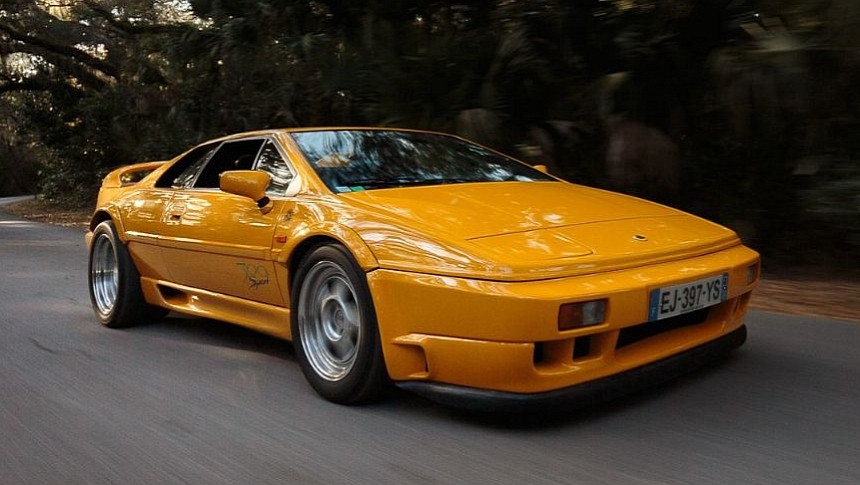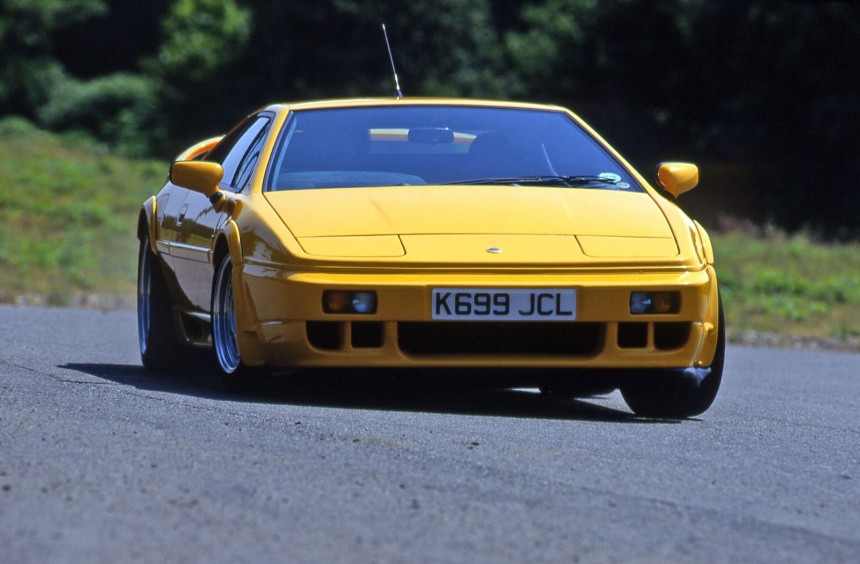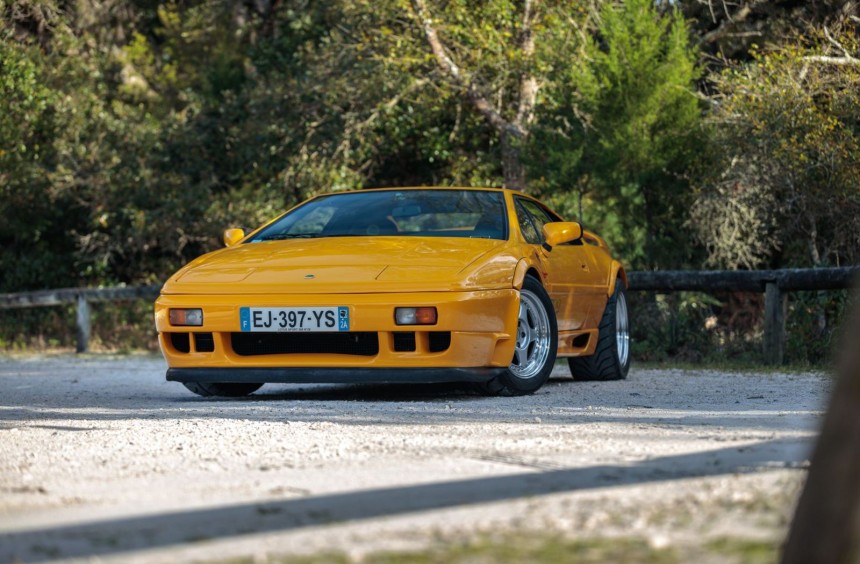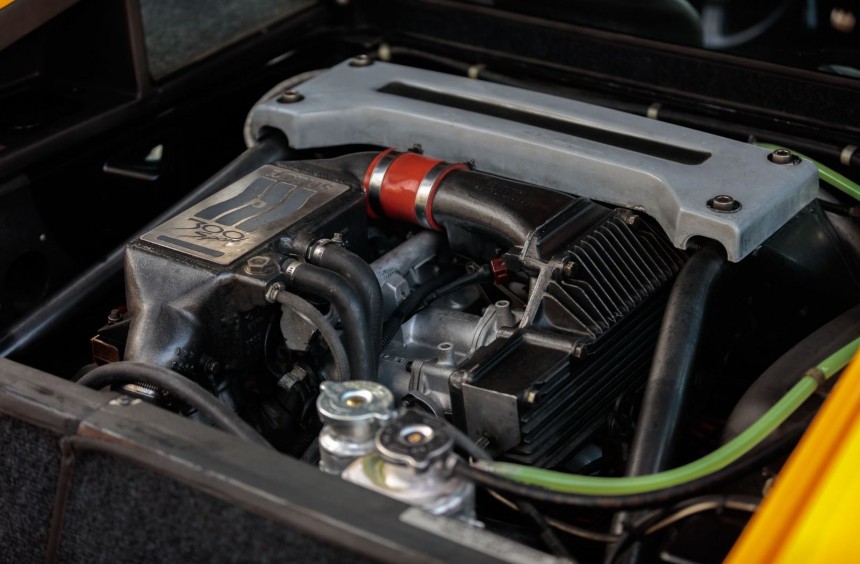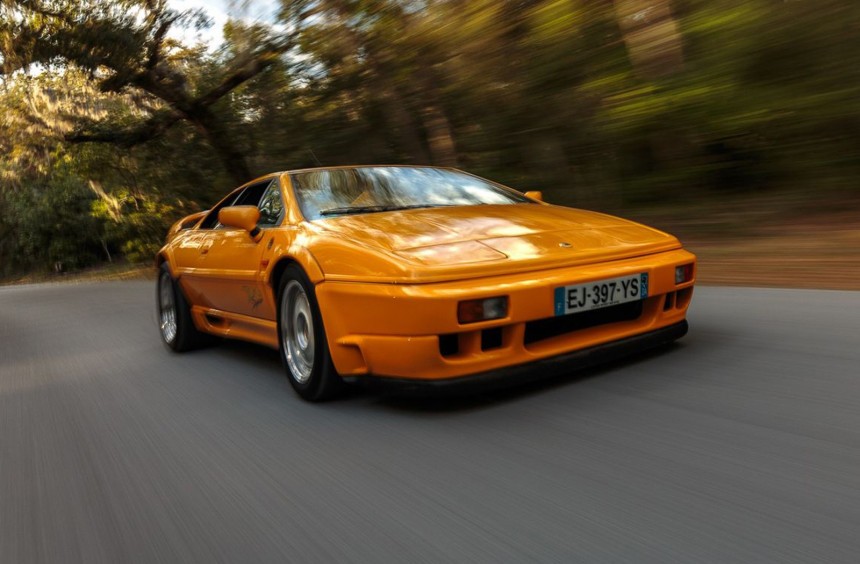Though three decades have passed since it was unveiled, and many have forgotten that it exists, this racecar-derived homologation special remains one of the greatest mid-engine sports cars ever produced.
Founded in the 1950s by the great Colin Chapman and his former college classmate, Colin Dare, Lotus was one of the biggest names in motorsport from the early 1960s to the late 1980s.
It quickly became a force in Formula 1, winning seven constructors' and six drivers' championships. It also regularly competed in America's IndyCar series and won the prestigious Indy 500 in 1965.
With an emphasis on lightweight, simple vehicles and constant innovation, Lotus contributed to the fast-paced evolution of motorsport with inventions such as the so-called Chapman strut rear independent suspension system and the now-widely-used monocoque chassis.
The English company applied the same philosophy to its long list of road car series, most of which became iconic thanks to their near-flawless handling.
Among the most iconic, longest-running, and most popular Lotus production models of all time was the wedge-shaped Esprit.
Produced in four distinct series, the model line gave birth to one of the greatest yet most underrated mid-engine sports cars ever built: the Sport 300.
Designed by the famous Italian stylist Giorgetto Giugiaro, the Series 1 Esprit debuted at the Paris Motor Show in October 1975.
A mid-engine sports car that made an unforgettable appearance in the era's James Bond film The Spy Who Loved Me as the famous submersible nicknamed Wet Nellie, the S1 was only produced for two years (1976-1978).
Sales of the initial model were relatively poor, but Lotus didn't give up on the Esprit and improved it in the following years. Therefore, the next three series were much more successful.
The vast majority of Esprits were powered by inline fours, but the fourth and last series was available with a potent twin-turbo V8 from the 1996 model year onwards.
The most powerful street-legal Esprit used a 350-hp version of the eight-cylinder and was accordingly named Sport 350. However, its inline-four-powered predecessor was unquestionably the greatest Esprit and, arguably, the greatest road-going Lotus of all time.
In the late 1980s, British designer Peter Stevens, who would later help design the iconic McLaren F1, was tasked with refreshing Giugiaro's original design employed by the S1, S2, and S3.
The resulting model produced from 1988 to 1994 received a new fiberglass body with far more rounded shapes and a new, upscale interior.
But, since it didn't receive any mechanical improvements, the refreshed model wasn't officially designated Series 4, and it's now differentiated from the S3 and S4 by its official codename, X180.
The X180 took the Esprit to the next level in terms of styling and was also the first version of the sports car to be heavily involved in motorsport.
In 1990, Lotus (then owned by GM) developed the X180-based Type 105 race car to boost the model's image in the US and entered it in several competitions, including the SCCA Escort World Challenge and IMSA Supercar Championship.
Later that year, an improved version called X180R was introduced alongside a US-only, limited-edition street-legal version with the same name.
The X180R ended up winning the IMSA Supercar Championship in 1992, and a year later, the British manufacturer unveiled the Sport 300, another limited-edition road car with strong ties to the racing project.
Unveiled at the Birmingham Motor Show in October 1992, the new model was created to homologate an upgraded race car for GT class racing and offer European customers the ultimate Esprit.
Unlike today, when street-legal track weapons like the Porsche 911 GT3 come with in-your-face aero modifications, the Sport 300 featured subtle changes to the stock Esprit bodywork.
These included a restyled front bumper with integrated brake cooling ducts, a new rear wing, and wheel arch extensions all around.
The extensions were added to make room for the iconic model's most striking visual feature, the big five-spoke OZ Racing wheels.
Measuring 16 inches at the front and 17 inches at the rear, the three-piece wheels wrapped in Goodyear GS-G rubber popped out metaphorically and literally, signaling this was no ordinary Esprit.
That was further emphasized by the spartan interior that received lightweight bucket seats and didn't feature unnecessary amenities like air conditioning or a stereo - albeit customers could optionally add both features as well as a full roll cage.
With the simplified cabin and extensive use of composite components, the Sport 300 was 176 pounds (80 kg) lighter than the stock Esprit, which tipped the scales at 3,011.5 pounds (1,366 kg) without fluids.
Hidden from plain sight, the upgrades included a modified cross member, an engine bay cross-brace, and a beefier backbone, all of which increased torsional rigidity.
Its fully independent suspension was shared with the standard Esprit, but engineers added stiffer bushings, shocks, and springs. In addition, they tweaked the geometry and modified the rear hub carriers, allowing the top link to become adjustable.
The suspension modifications amounted to a slight increase in the front track and widened the rear by a sensible two inches (50 mm). More importantly, it improved the already near-flawless maneuverability that the Esprit was famous for.
Stopping power was also enhanced by adding larger ventilated discs hugged by four-piston AP Racing calipers and backed up by a Delco anti-lock system (ABS).
Chassis upgrades aside, the definite proof that this was an Esprit of epic proportions laid under the engine cover.
A special version of the type 910S 2.2-liter, the twin-cam 16-valve engine, was the same all-aluminum unit that powered the X180R race car.
Compared to the standard 910S, this version utilized an upgraded Zeus cylinder head (named after the company that cast it) with enlarged intake valves and a larger Garrett hybrid turbocharger that breathed through an upgraded air-water-air intercooler (called Chargecooler by Lotus).
The engine also received a recalibrated ECU and slightly more boost, enabling it to make 302 hp and send 271 lb-ft (367 Nm) of twist to the rear wheels through a five-speed manual and a limited-slip diff.
The engine's power-to-weight ratio was in the same territory as the Porsche 964 Turbo 3.6, and in terms of performance, it helped the Sport 300 sprint from a standstill to 60 mph (97 kph) in 4.7 seconds - slightly quicker than the 1990 Sport 350, its twin-turbo V8-powered successor.
Considering those performance figures, calling the Sport 300 one of the greatest mid-engine sports cars ever built and arguably the greatest road-legal Lotus might seem like a huge exaggeration.
Many think that a great sports car has to be among the fastest and most powerful, which this Esprit never was. But, I believe the driving experience it delivers is the ultimate factor that separates good sports cars from great ones.
From this point of view, the Sport 300 is a mid-engine sports car that flirts with perfection, even three decades after it was introduced.
If you read any reviews, watch a video like the one below by Carfection, or if you're lucky enough to drive one, you'll understand that I'm not exaggerating.
With minimal electronic aids, an incredible suspension setup, and an engine that delivers the right amount of power to make the car fast but still controllable in any situation, the Sport 300 is an epic driver's car.
It behaves extraordinarily well on a winding public road and feels at home on a race track, where it can embarrass modern track cars with the right driver behind the wheel.
Lotus initially planned a 50-unit production run but eventually made 64, all sold in Europe.
Despite its rarity and epicness, this fantastic Esprit's current value stands around $75,000. Though not a small amount by any means, this value makes the Sport 300 way cheaper than far less impressive sports cars.
However, those who own one know that it's worth a lot more, so finding one for sale is a rare occurrence.
These days, the Esprit is rarely talked about, and many enthusiasts have never heard about the limited-edition Sport 300. But that doesn't change the fact that this English masterpiece remains one of the greatest mid-engine sports cars to ever grace the streets.
It quickly became a force in Formula 1, winning seven constructors' and six drivers' championships. It also regularly competed in America's IndyCar series and won the prestigious Indy 500 in 1965.
With an emphasis on lightweight, simple vehicles and constant innovation, Lotus contributed to the fast-paced evolution of motorsport with inventions such as the so-called Chapman strut rear independent suspension system and the now-widely-used monocoque chassis.
The English company applied the same philosophy to its long list of road car series, most of which became iconic thanks to their near-flawless handling.
Among the most iconic, longest-running, and most popular Lotus production models of all time was the wedge-shaped Esprit.
Produced in four distinct series, the model line gave birth to one of the greatest yet most underrated mid-engine sports cars ever built: the Sport 300.
A brief history of the Esprit
A mid-engine sports car that made an unforgettable appearance in the era's James Bond film The Spy Who Loved Me as the famous submersible nicknamed Wet Nellie, the S1 was only produced for two years (1976-1978).
Sales of the initial model were relatively poor, but Lotus didn't give up on the Esprit and improved it in the following years. Therefore, the next three series were much more successful.
The vast majority of Esprits were powered by inline fours, but the fourth and last series was available with a potent twin-turbo V8 from the 1996 model year onwards.
The most powerful street-legal Esprit used a 350-hp version of the eight-cylinder and was accordingly named Sport 350. However, its inline-four-powered predecessor was unquestionably the greatest Esprit and, arguably, the greatest road-going Lotus of all time.
It all started on the track
The resulting model produced from 1988 to 1994 received a new fiberglass body with far more rounded shapes and a new, upscale interior.
But, since it didn't receive any mechanical improvements, the refreshed model wasn't officially designated Series 4, and it's now differentiated from the S3 and S4 by its official codename, X180.
The X180 took the Esprit to the next level in terms of styling and was also the first version of the sports car to be heavily involved in motorsport.
In 1990, Lotus (then owned by GM) developed the X180-based Type 105 race car to boost the model's image in the US and entered it in several competitions, including the SCCA Escort World Challenge and IMSA Supercar Championship.
Later that year, an improved version called X180R was introduced alongside a US-only, limited-edition street-legal version with the same name.
The X180R ended up winning the IMSA Supercar Championship in 1992, and a year later, the British manufacturer unveiled the Sport 300, another limited-edition road car with strong ties to the racing project.
A subtle-looking race car for the road
Unlike today, when street-legal track weapons like the Porsche 911 GT3 come with in-your-face aero modifications, the Sport 300 featured subtle changes to the stock Esprit bodywork.
These included a restyled front bumper with integrated brake cooling ducts, a new rear wing, and wheel arch extensions all around.
The extensions were added to make room for the iconic model's most striking visual feature, the big five-spoke OZ Racing wheels.
Measuring 16 inches at the front and 17 inches at the rear, the three-piece wheels wrapped in Goodyear GS-G rubber popped out metaphorically and literally, signaling this was no ordinary Esprit.
That was further emphasized by the spartan interior that received lightweight bucket seats and didn't feature unnecessary amenities like air conditioning or a stereo - albeit customers could optionally add both features as well as a full roll cage.
With the simplified cabin and extensive use of composite components, the Sport 300 was 176 pounds (80 kg) lighter than the stock Esprit, which tipped the scales at 3,011.5 pounds (1,366 kg) without fluids.
Extensive chassis upgrades
The Sport 300 might not have delivered clear visual hints that it was a homologation special evolved from the IMSA Supercar Championship-winning X180R. Still, one look at the chassis upgrades and its motorsport pedigree became evident.
Hidden from plain sight, the upgrades included a modified cross member, an engine bay cross-brace, and a beefier backbone, all of which increased torsional rigidity.
Its fully independent suspension was shared with the standard Esprit, but engineers added stiffer bushings, shocks, and springs. In addition, they tweaked the geometry and modified the rear hub carriers, allowing the top link to become adjustable.
The suspension modifications amounted to a slight increase in the front track and widened the rear by a sensible two inches (50 mm). More importantly, it improved the already near-flawless maneuverability that the Esprit was famous for.
Stopping power was also enhanced by adding larger ventilated discs hugged by four-piston AP Racing calipers and backed up by a Delco anti-lock system (ABS).
Powered by the most potent inline-four ever fitted into a production Esprit
A special version of the type 910S 2.2-liter, the twin-cam 16-valve engine, was the same all-aluminum unit that powered the X180R race car.
Compared to the standard 910S, this version utilized an upgraded Zeus cylinder head (named after the company that cast it) with enlarged intake valves and a larger Garrett hybrid turbocharger that breathed through an upgraded air-water-air intercooler (called Chargecooler by Lotus).
The engine also received a recalibrated ECU and slightly more boost, enabling it to make 302 hp and send 271 lb-ft (367 Nm) of twist to the rear wheels through a five-speed manual and a limited-slip diff.
The engine's power-to-weight ratio was in the same territory as the Porsche 964 Turbo 3.6, and in terms of performance, it helped the Sport 300 sprint from a standstill to 60 mph (97 kph) in 4.7 seconds - slightly quicker than the 1990 Sport 350, its twin-turbo V8-powered successor.
A near-perfect mid-engine sports car
Many think that a great sports car has to be among the fastest and most powerful, which this Esprit never was. But, I believe the driving experience it delivers is the ultimate factor that separates good sports cars from great ones.
From this point of view, the Sport 300 is a mid-engine sports car that flirts with perfection, even three decades after it was introduced.
If you read any reviews, watch a video like the one below by Carfection, or if you're lucky enough to drive one, you'll understand that I'm not exaggerating.
With minimal electronic aids, an incredible suspension setup, and an engine that delivers the right amount of power to make the car fast but still controllable in any situation, the Sport 300 is an epic driver's car.
It behaves extraordinarily well on a winding public road and feels at home on a race track, where it can embarrass modern track cars with the right driver behind the wheel.
Extremely rare, but not as expensive as you think
Despite its rarity and epicness, this fantastic Esprit's current value stands around $75,000. Though not a small amount by any means, this value makes the Sport 300 way cheaper than far less impressive sports cars.
However, those who own one know that it's worth a lot more, so finding one for sale is a rare occurrence.
These days, the Esprit is rarely talked about, and many enthusiasts have never heard about the limited-edition Sport 300. But that doesn't change the fact that this English masterpiece remains one of the greatest mid-engine sports cars to ever grace the streets.
